
Brassicaceae or Cruciferae is a medium-sized and economically important family of flowering plants commonly known as the mustards, the crucifers, or the cabbage family. Most are herbaceous plants, while some are shrubs. The leaves are simple, lack stipules, and appear alternately on stems or in rosettes. The inflorescences are terminal and lack bracts. The flowers have four free sepals, four free alternating petals, two shorter free stamens and four longer free stamens. The fruit has seeds in rows, divided by a thin wall.

Watercress or yellowcress is a species of aquatic flowering plant in the cabbage family Brassicaceae.
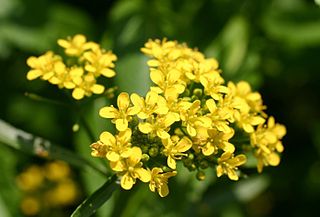
Rorippa is a genus of flowering plants in the family Brassicaceae, native to Europe through central Asia, Africa, and North America. Rorippa species are annual to perennial herbs, usually with yellow flowers and a peppery flavour. They are known commonly as yellowcresses.

Raphanus raphanistrum, also known as wild radish, white charlock or jointed charlock, is a flowering plant in the family Brassicaceae. One of its subspecies, Raphanus raphanistrum subsp. sativus, includes a diverse variety of cultivated radishes. The species is native to western Asia, Europe and parts of Northern Africa. It has been introduced into most parts of the world and is regarded as a habitat threatening invasive species in many areas, for example, Australia. It spreads rapidly and is often found growing on roadsides or in other places where the ground has been disturbed.

Lathyrus palustris is a species of wild pea known by the common name marsh pea. It is native to Europe, Asia, and North America. It is a perennial herb with leaves made up of oval-shaped or oblong leaflets a few centimeters long. It has branched, coiled tendrils. The plant bears an inflorescence of two to eight pinkish purple pea flowers each up to two centimeters wide. The fruit is a dehiscent legume pod.

Rorippa palustris, marsh yellow cress, is a species of flowering plant in the family Brassicaceae. It is widespread and native to parts of Africa, and much of Asia, Europe and Eurasia, North America and the Caribbean. It can also be found in other parts of the world as an introduced species and a common weed, for example, in Australia and South America. It is an adaptable plant which grows in many types of damp, wet, and aquatic habitat. It may be an annual, biennial, or perennial plant, and is variable in appearance as well.
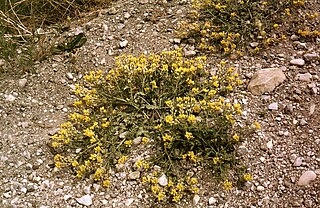
Rorippa columbiae is a species of flowering plant in the family Brassicaceae known by the common names Columbian yellowcress and Columbia yellow cress.

Rorippa curvipes is a species of flowering plant in the family Brassicaceae known by the common name bluntleaf yellowcress. It is native to much of western North America from Alaska to Mexico to the Mississippi River, where it can be found in various types of moist and wet habitat, including lakeshores and riverbanks, meadows, roadsides, mudflats, and irrigation ditches. It is an annual or perennial herb, producing several stems growing prostrate along the ground or somewhat upright, measuring 10 centimeters to around half a meter in maximum length. The leaves are long and narrow, smooth edged or lobed, the lobes sometimes cut all the way to the midrib or separated to form leaflets. Lower leaves are borne on petioles; upper leaves have bases that clasp the stem. The mustardlike flowers have very small yellow petals. The fruit is a plump, hairless silique containing many minute seeds.
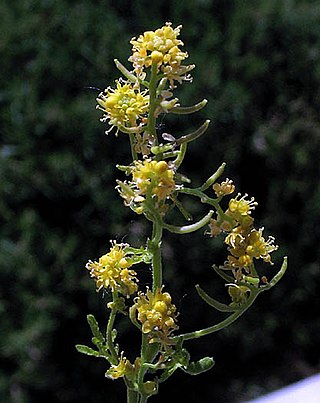
Rorippa curvisiliqua is a species of flowering plant in the family Brassicaceae known by the common name curvepod yellowcress.
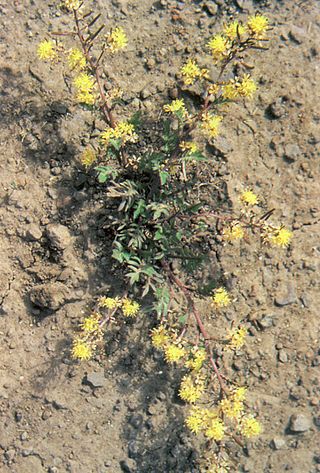
Rorippa sinuata is a species of flowering plant in the family Brassicaceae known by the common name spreading yellowcress. It is native to North America, including most all of the western and central United States, where it grows in many types of moist and wet habitat, such as lakeshores and riverbanks, meadows, and mudflats. It is a perennial herb producing spreading stems up to 40 or 50 centimeters long. It is densely hairy, the hairs rounded like sacs or vesicles. The leaves are up to 8 centimeters long and have blades are deeply toothed, lobed, or divided into smaller leaflets. The inflorescence is an elongated raceme occupying the top portion of the stem containing many tiny yellow flowers just a few millimeters long. The fruit is a curved silique which is variable in size and shape but generally contains many minute seeds.
Rorippa sphaerocarpa is a species of flowering plant in the family Brassicaceae known by the common name roundfruit yellowcress. It is native to North America, including the western United States and northern Mexico, where it grows in moist habitat, such as riverbanks and mudflats. It is an annual herb producing decumbent or erect stems up to 40 centimeters long. The leaves are up to 10 centimeters long and have blades are deeply divided into toothed lobes. The inflorescence is a raceme of mustardlike flowers with yellow petals each no more than a millimeter long. The fruit is a round silique 1 or 2 millimeters wide.

Rorippa subumbellata is a rare species of flowering plant in the family Brassicaceae known by the common names Lake Tahoe yellowcress and Tahoe yellow cress. It is known only from the shores of Lake Tahoe, straddling the border between California and Nevada. There are an estimated fourteen populations of the plant still in existence. It grows only on the direct shoreline of the lake, occupying a seven-foot semi-aquatic zone between the high- and low-tide marks. It is directly impacted by recreational activities on the lake, enduring bombardment by boat wakes, trampling, and construction of docks and other structures.

Sisymbrium orientale is a species of flowering plant in the family Brassicaceae known by the common names Indian hedgemustard and eastern rocket. It is native to Europe, Asia, and North Africa, and it can be found throughout much of the temperate world as an introduced species and in some areas a common roadside weed. It is an annual herb producing a hairy, branching stem up to about 30 centimeters tall. The basal leaves are divided into deep lobes or toothed leaflets. Leaves higher on the stem have lance-shaped blades with small separate lobes near the base. The top of the stem is occupied by a raceme of flowers with light yellow petals each measuring up to a centimeter long. The fruit is a silique which can be up to 10 centimeters long.

Tropidocarpum gracile is a species of flowering plant in the family Brassicaceae known by the common name dobie pod. It is native to California and Baja California, where it can be found in many types of habitat from coastal canyons to inland mountains and deserts in chaparral, scrub, woodlands, beaches, valleys, and washes. It is an annual herb producing a decumbent to erect, spreading, branching stem 10 to 50 centimeters in length. It is coated in short and long rough hairs. The basal leaves are up to 10 to 15 centimeters long and are divided into elongated lobes along the edges; leaves higher on the stem are shorter and sometimes less divided. The inflorescence is an open raceme of mustardlike flowers with four petals each about 4 millimeters long. The petals are yellow and sometimes purple-tinged. The fruit is a narrow silique several centimeters in length containing tiny brown seeds.
Boechera yorkii is a rare species of flowering plant in the mustard family known by the common name Last Chance rockcress. It is endemic to Inyo County, California, where it is known only from the Last Chance Range in Death Valley National Park. There are only two occurrences known, but the plant occurs in remote, nearly inaccessible mountain territory, so more plants may exist unobserved. The species was only described to science in 2004. Its habitat is rocky mountain canyons on cliffs of dolomite.

Elaeagnus pungens is a species of flowering plant in the family Elaeagnaceae, known by the common names thorny olive, spiny oleaster and silverthorn; also by the family name "oleaster". It is native to Asia, including China and Japan. It is present in the southeastern United States as an introduced species, a common landscaping and ornamental plant, and sometimes an invasive species.
Physaria parviflora is a species of flowering plant in the family Brassicaceae known by the common names Piceance bladderpod and frosty bladderpod. It is endemic to Colorado in the United States, where it occurs in Garfield, Mesa, and Rio Blanco Counties.
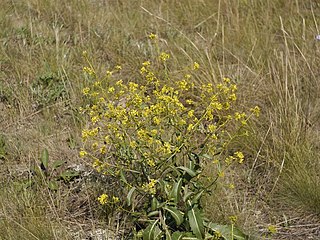
Brassica elongata, the elongated mustard or long-stalked rape, is a species of the mustard plant that is native to parts of Central Europe, Eastern Europe, the Balkan Peninsula, the Caucasus, Morocco and parts of Central Asia. Through plant invasion this species has become naturalized in many other parts of the world. Some of these naturalized regions include South Africa, North Western Europe, Australia and North America. Given the wide range of climate and ecological conditions of these regions, B. elongata has been able to disrupt the ecosystems of their native plant habitats and has been label as an invasive species in many of its naturalized zones. In North America, this species is often found as a roadside weed in the southwestern states, particularly in the state of Nevada. Studies allude that the Cruciferae might have migrated through the Bering land bridge from what is now Central Asia. Commonly known as the long-stalked rape or as langtraubiger Kohl in German, this species is a close cousin to Brassica napus (rapeseed) and a secondary genetic relative to B. oleracea (kale). As a close genetic species of the rapeseed, the long-stalked rape has one of the highest counts of accumulated polyunsaturated linoleic and linolenic acid. Both compounds are heavily used to manufacture vegetable oils. Brassica elongata has the propagative potential of turning into a horticultural product from what is currently a noxious weed.

Physaria tenella is a species of flowering plant in the family Brassicaceae known by the common names Moapa bladderpod and slender bladderpod. It is native to western North America from Utah to Sonora, where it grows mainly in desert habitat. This is an annual herb producing several hairy multibranched erect to spreading stems sometimes exceeding half a meter long. The basal leaves are up to 6.5 centimeters long and sometimes toothed, and there are smaller leaves higher on the stem. The inflorescence is a raceme of flowers at the tip of the stem. The mustardlike flower has four orange to bright yellow petals each up to a centimeter long. The fruit is a plump, hairy, rounded capsule containing flat orange seeds.

Nasturtium gambellii is a rare species of flowering plant in the mustard family known by the common names Gambel's yellowcress and Gambel's watercress. It is known from three or four scattered occurrences in California. It is also native to central Mexico and Guatemala. Its total U.S. population was last estimated at fewer than 300 individuals. It was federally listed in California, as an endangered species of the United States in 1993.

















